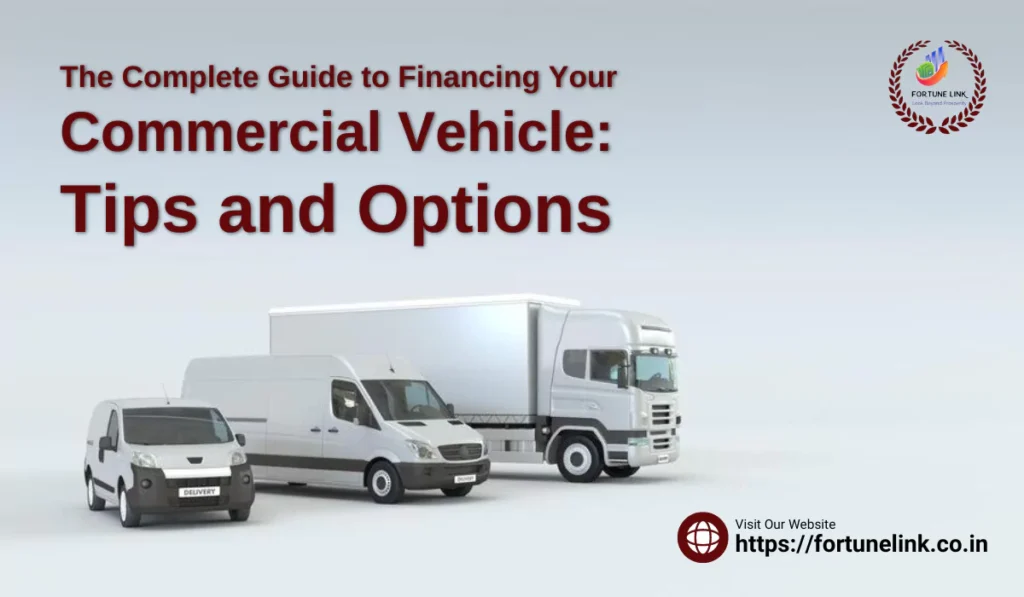
Securing financing for commercial vehicles is a critical step for businesses looking to expand their operations and improve logistics. Whether you’re a small business owner or part of a large enterprise, understanding the various financing options available can help you make informed decisions that align with your financial goals and operational needs. In this comprehensive guide, we’ll explore key tips and options for financing your commercial vehicle.
1. Understand Your Financing Options
a. Traditional Bank Loans
Traditional bank loans are a common financing option for commercial vehicles. These loans typically offer competitive interest rates and flexible terms. However, they often require a strong credit history and substantial documentation. Banks may also require collateral, which could include the vehicle itself or other business assets.
Pros:
- Competitive interest rates.
- Flexible terms.
Cons:
- Requires strong credit history.
- Extensive documentation and collateral.
b. Equipment Financing
Equipment financing is specifically designed for purchasing business-related equipment, including commercial vehicles. This option uses the vehicle itself as collateral, which can make it easier to secure compared to traditional loans. Equipment financing often provides faster approval processes and can be easier to obtain for businesses with moderate credit.
Pros:
- Easier to secure with moderate credit.
- Faster approval process.
Cons:
- May have higher interest rates compared to traditional loans.
c. Lease Financing
Leasing is an attractive option for businesses that prefer lower upfront costs and the flexibility to upgrade vehicles regularly. Lease agreements typically include maintenance and repair services, reducing operational hassles. There are two main types of leases: operating leases and capital leases. Operating leases are treated as rental agreements, while capital leases are more like a loan.
Pros:
- Lower upfront costs.
- Maintenance and repairs often included.
Cons:
- You don’t own the vehicle.
- May have mileage and use restrictions.
d. Manufacturer Financing
Many vehicle manufacturers offer financing programs tailored to their commercial customers. These programs often include special incentives such as lower interest rates, deferred payments, or bundled maintenance packages. Manufacturer financing can be convenient as it simplifies the purchasing process.
Pros:
- Special incentives and lower interest rates.
- Simplified purchasing process.
Cons:
- Limited to specific manufacturers.
- May have stricter terms.
e. Alternative Financing
Alternative financing options, such as online lenders and peer-to-peer lending platforms, provide more flexible terms and faster approval processes. These options can be beneficial for businesses with less-than-perfect credit scores. They often require less documentation and offer more innovative financing solutions.
Pros:
- Flexible terms and faster approval.
- Suitable for businesses with lower credit scores.
Cons:
- May have higher interest rates.
- Less regulated than traditional lenders.
2. Evaluate Your Financial Health
Before applying for financing, it’s crucial to evaluate your financial health. Consider the following factors:
Credit Score: A higher credit score can improve your chances of securing favorable loan terms. Check your credit report for errors and work on improving your score if necessary. Strategies to improve your credit score include paying down existing debts, making timely payments, and correcting any inaccuracies in your credit report.
Cash Flow: Ensure your business has a steady cash flow to manage monthly payments comfortably. Lenders will review your cash flow to assess your ability to repay the loan. Maintaining detailed financial records and demonstrating consistent revenue can strengthen your application.
Debt-to-Income Ratio: A lower debt-to-income ratio indicates better financial stability and can improve your loan approval chances. Aim to keep your debt-to-income ratio below 40%. This ratio is calculated by dividing your total monthly debt payments by your gross monthly income.
3. Compare Interest Rates and Terms
Interest rates and loan terms can significantly impact the overall cost of financing. Compare offers from multiple lenders to find the most competitive rates. Pay attention to:
Annual Percentage Rate (APR): The APR includes the interest rate and other fees, providing a comprehensive view of the loan cost. A lower APR means lower overall costs.
Loan Term: Longer terms result in lower monthly payments but higher overall interest costs. Choose a term that balances affordability and total cost. For instance, a 60-month loan will have higher monthly payments but lower interest costs than a 72-month loan.
Fixed vs. Variable Rates: Fixed interest rates remain constant throughout the loan term, providing stability in payments. Variable rates can fluctuate with market conditions, which may lead to lower initial payments but higher costs over time. Assess your risk tolerance and financial stability when deciding between fixed and variable rates.
4. Consider Down Payments and Trade-Ins
Making a substantial down payment can reduce the loan amount and lower monthly payments. Additionally, trading in an old vehicle can offset the cost of the new purchase. Assess the value of your current vehicles and negotiate trade-in deals with dealers.
Down Payments: A down payment of at least 20% is often recommended to secure better loan terms and reduce overall interest costs. Larger down payments can also enhance your negotiating position with lenders.
Trade-Ins: When trading in a vehicle, ensure you get a fair market value. Consider getting multiple trade-in quotes from different dealers to maximize the value. The trade-in value can significantly reduce the amount you need to finance.
5. Plan for Additional Costs
When budgeting for commercial vehicle financing, consider additional costs such as:
Insurance: Commercial vehicle insurance is essential and often more expensive than personal auto insurance. Ensure your coverage meets legal requirements and protects your investment. Shop around for the best rates and consider bundling policies to save on premiums.
Maintenance and Repairs: Regular maintenance is crucial to keep your vehicles in optimal condition and minimize downtime. Budget for routine maintenance, unexpected repairs, and the cost of replacement parts. Establishing a maintenance schedule can help you avoid costly breakdowns and extend the lifespan of your vehicles.
Registration and Taxes: Be prepared for registration fees and taxes associated with commercial vehicles. These costs vary by location and can add up quickly. Factor these expenses into your overall budget to avoid surprises.
Fuel Costs: Fuel is a significant ongoing expense for commercial vehicles. Consider the fuel efficiency of the vehicles you’re financing and explore options to reduce fuel consumption, such as driver training and route optimization.
Licensing and Permits: Depending on your industry and the type of vehicles you’re financing, you may need specific licenses and permits. Ensure you understand the requirements and budget for the associated costs.
6. Understand Your Business Needs
Choosing the right financing option also involves understanding your business needs and how the new vehicle will fit into your operations. Consider the following:
Vehicle Type: Ensure the vehicle you’re financing meets your operational requirements. For example, if you need to transport heavy goods, a truck with a higher payload capacity is essential.
Usage: Consider how frequently and intensively the vehicle will be used. High usage may justify a more robust and expensive vehicle, while occasional use might allow for a more economical choice.
Growth Plans: If you plan to expand your fleet in the future, choose a financing option that supports scalability. Some lenders offer fleet financing solutions that make it easier to add more vehicles as your business grows.
Technology and Features: Modern commercial vehicles come with various technological advancements that can improve efficiency and safety. Evaluate the features that are most beneficial for your business and factor them into your financing decision.
7. Seek Professional Advice
Navigating commercial vehicle financing can be complex, and seeking professional advice can be beneficial. Financial advisors, accountants, and business consultants can provide valuable insights tailored to your specific situation. They can help you understand the financial implications of different financing options and assist in structuring deals that align with your business goals.
Conclusion
Choosing the right financing option for your commercial vehicle requires careful consideration of various factors, including your financial health, the available financing options, and the total cost of ownership. By understanding these elements and following the tips outlined in this guide, you can make informed decisions that support your business growth and operational efficiency.
For personalized advice and the latest financing options tailored to your business needs, feel free to reach out to our team at FortuneLink Finance. We’re here to help you navigate the complexities of commercial vehicle financing and achieve your business goals.
About FortuneLink Finance
At FortuneLink Finance, we’re dedicated to providing transparent, expert, and personalized financial solutions for businesses of all sizes. Our comprehensive range of services is designed to meet your unique needs, ensuring a seamless and successful financing journey. Contact us today to learn more about how we can support your commercial vehicle financing needs.
Connect with Us
🔗 Visit our website: fortunelink.co.in
📞 Call us: +91 8788885812


 Previous Post
Previous Post Next Post
Next Post